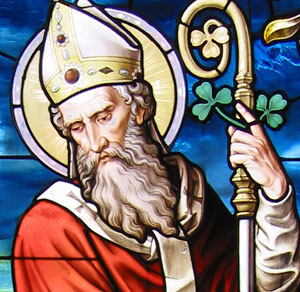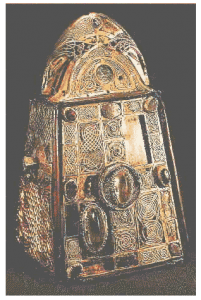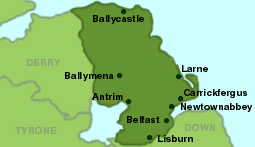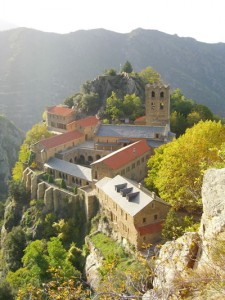
A depiction of St. Patrick. (Credit: Corbis)
Saint Patrick, The Apostle of Ireland, was born at what is now Kilpatrick, near Dumbarton, in Scotland, in the year 387; died at Saul, Downpatrick, Ireland, 17 March, 493. At the time of his birth it was known at Briton and ruled by Rome. His parents were Calphurnius and Conchessa. The language of the time was latin and his given name was Patricus. His father belonged to a Roman family of high rank and held the office of decurio in Briton. Conchessa was a near relative of the great patron of Gaul, St. Martin of Tours. Kilpatrick still retains many memorials of Saint Patrick, and frequent pilgrimages continued far into the Middle Ages to perpetuate there the fame of his sanctity and miracles. The old pre-reformation church had a shrine and bell dedicated to him – in the parish till 1798, now both in Dublin, Ireland – adjoining the church is St. Patrick’s well, believed to have sacred and healing waters. Strathblane parish also has a well in his name. The chapel of Dumbarton Castle was dedicated to him.

The old pre-reformation church bell dedicated to St. Patrick
In his sixteenth year, Patrick was carried off into captivity by Irish marauders and was sold as a slave to a chieftan named Milchu in Dalriada, a territory of the present county of Antrim in Ireland, where for six years he tended his master’s flocks in the valley of the Braid and on the slopes of Slemish, near the modern town of Ballymena. He relates in his “Confessio” that during his captivity while tending the flocks he prayed many times in the day: “the love of God”, he added, “and His fear increased in me more and more, and the faith grew in me, and the spirit was roused, so that, in a single day, I have said as many as a hundred prayers, and in the night nearly the same, so that whilst in the woods and on the mountain, even before the dawn, I was roused to prayer and felt no hurt from it, whether there was snow or ice or rain; nor was there any slothfulness in me, such as I see now, because the spirit was then fervent within me.” In the ways of a benign Providence the six years of Patrick’s captivity became a remote preparation for his future apostolate. He acquired a perfect knowledge of the Celtic tongue in which he would one day announce the glad tidings of Redemption, and, as his master Milchu was a druidical high priest, he became familiar with all the details of Druidism from whose bondage he was destined to liberate the Irish race.

County Antrim in Ireland
Admonished by an angel he, after six years, fled from his cruel master and bent his steps towards the west. He relates in his “Confessio” that he had to travel about 200 miles; and his journey was probably towards Killala Bay and onwards thence to Westport. He found a ship ready to set sail and after some rebuffs was allowed on board. In a few days he was among his friends once more in Briton, but now his heart was set on devoting himself to the service of God in the sacred ministry. We meet with him at St. Martin’s monastery at Tours, and again at the island sanctuary of Lérins which was just then acquiring widespread renown for learning and piety; and wherever lessons of heroic perfection in the exercise of Christian life could be acquired, thither the fervent Patrick was sure to bend his steps. No sooner had St. Germain entered on his great mission at Auxerre than Patrick put himself under his guidance, and it was at that great bishop’s hands that Ireland’s future apostle was a few years later promoted to the priesthood. It is the tradition in the territory of the Morini that Patrick under St. Germain’s guidance for some years was engaged in missionary work among them. When Germain commissioned by the Holy See proceeded to Briton to combat the erroneous teachings of Pelagius, he chose Patrick to be one of his missionary companions and thus it was his privilege to be associated with the representative of Rome in the triumphs that ensued over heresy and Paganism, and in the many remarkable events of the expedition, such as the miraculous calming of the tempest at sea, the visit to the relics at St. Alban’s shrine, and the Alleluia victory. Amid all these scenes, however, Patrick’s thoughts turned towards Ireland, and from time to time he was favored with visions of the children from Focluth, by the Western sea, who cried to him: “O holy youth, come back to Erin, and walk once more amongst us.”

St Martin Monastery in France
It was probably in the summer months of the year 433, that Patrick and his companions landed at the mouth of the Vantry River close by Wicklow Head. The Druids were at once in arms against him. But Patrick was not disheartened. The intrepid missionary resolved to search out a more friendly territory in which to enter on his mission. First of all, however, he would proceed towards Dalriada, where he had been a slave, to pay the price of ransom to his former master, and in exchange for the servitude and cruelty endured at his hands to impart to him the blessings and freedom of God’s children. He rested for some days at the islands off the Skerries coast, one of which still retains the name of Inis-Patrick, and he probably visited the adjoining mainland, which in olden times was known as Holm Patrick. Tradition fondly points out the impression of St. Patrick’s foot upon the hard rock — off the main shore, at the entrance to Skerries harbour.
